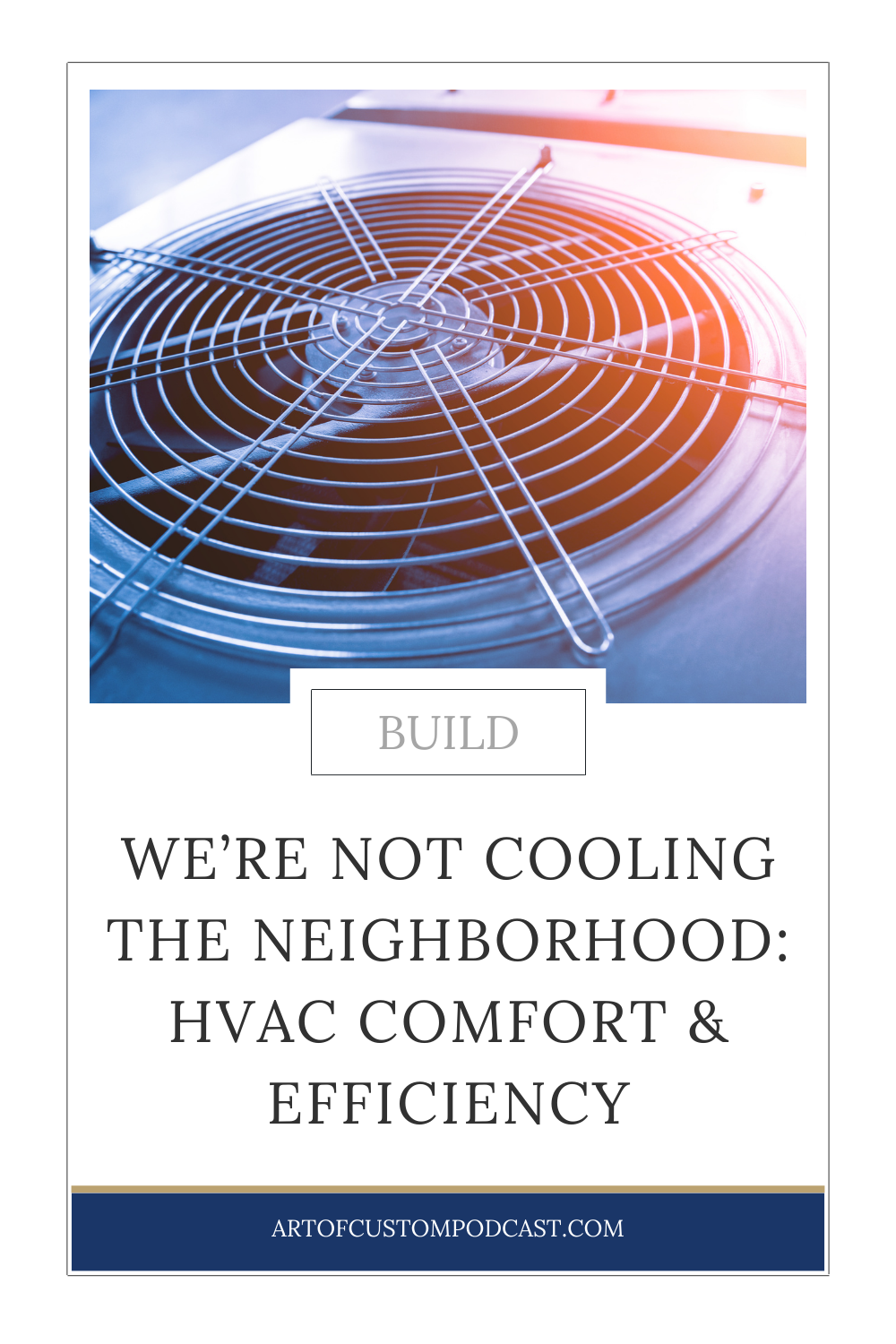High-Performance HVAC System Design
We're Not Cooling the Neighborhood: HVAC Comfort & Efficiency
It is the best of both worlds - being nice and cozy when it's cold out and staying cool and comfortable when it's a scorcher. And it all starts with the design and installation of your home's HVAC and air handling systems.
When building your new home there are options for making sure your systems are the most comfortable and efficient. To help you explore the choices you have and outline the considerations you'll want to take into account, Brad Hill from Hill & Mehr Heating & Air Conditioning in Northern Utah joins the show.
You can read the transcript below, or...
Episode Tool Box:

SEASON SIX, EPISODE TEN | TRANSCRIPT
Season Six of The Art of Custom wraps up with a deep dive into one of the most important (and misunderstood) systems in any home: heating, ventilation, and air conditioning. Brad Hill of H Heating & Cooling in northern Utah joins the show to talk about how modern HVAC design shapes comfort, efficiency, and indoor air quality in today’s high-performance homes.
From understanding system sizing and airflow calculations to filtration, duct sealing, zoning, and smart thermostats, this episode explores how science and technology have transformed what it means to live comfortably indoors.
The Science of a Comfortable Home
HVAC design has evolved far beyond the old rule of thumb of “one ton per 500 square feet.” Today’s systems are carefully engineered using Manual J and Manual D calculations for HVAC loads that analyze every variable from window area, insulation values, orientation, to heat gain or loss. These calculations determine the precise furnace and duct size needed for a home.
This scientific approach ensures consistent comfort across rooms, prevents oversizing, and lowers long-term operating costs.
Furnace Systems, Air Conditioners & Heat Pumps
Modern furnaces come in three main types:
- Single-Stage: Operates at full power every time it runs. Reliable but less efficient.
- Two-Stage: Uses a low setting most of the time, switching to high only when needed.
- Variable-Speed/Modulating: Adjusts automatically to deliver exactly the amount of heat or cooling required, running quietly and continuously for steady temperatures.
Variable-speed systems cost more up front, but pay back the investment within five to seven years through lower utility bills and longer equipment life.
High-efficiency air conditioners and heat pumps now use similar modulation technology.
- Modulating air conditioners deliver precise, quiet cooling.
- Heat pumps have improved dramatically and can now operate efficiently even in cold climates, offering attractive rebate incentives and reduced emissions.
The right choice depends on location and climate, but both technologies provide energy savings and comfort when properly sized and paired with the right furnace or air handler.
Zoning Your HVAC for Custom Comfort
Large homes or multi-level designs benefit from a zoned HVAC system with one central unit and automated dampers that direct air where it’s needed. Zoning lets homeowners maintain different temperatures in bedrooms, living areas, or sun-exposed spaces without installing multiple furnaces.
When designed correctly, zoning increases comfort, balances airflow, and cuts energy waste while simplifying maintenance.
Duct Design & Sealing
Efficient air delivery depends on tight, well-sealed ducts. Leaky metal systems can lose up to 40% of conditioned air, wasting energy and creating hot or cold spots.
Brad’s team uses mastic sealant and aeroseal technology to achieve less than 2% leakage, far exceeding ENERGY STAR requirements. They often build ducts with insulated fiber board, which prevents expansion noise, eliminates thermal loss, and keeps airflow smooth and quiet.
Air Filtration & Indoor Air Quality
High-performance homes rely on quality filtration to protect both homeowners and equipment. Every system Hibbs installs includes a media filtration system that captures fine particles and allergens while extending equipment life. Filters last six months or more, which is a major improvement over one-inch disposable filters that need replacement every 30 days.
Brad also recommends UV air scrubbers and whole-home humidifiers for families focused on health and comfort. These systems reduce viruses, bacteria, and dryness that can affect respiratory health, hardwoods, and cabinetry.
Ventilation: HRVs & ERVs
Today’s tight, energy-efficient homes require mechanical ventilation to bring in fresh air and remove stale air.
- HRVs (Heat Recovery Ventilators) recover heat from outgoing air—ideal for humid climates.
- ERVs (Energy Recovery Ventilators) balance both heat and moisture—best for dry regions.
Both systems keep air fresh, balanced, and healthy, preventing the “mason-jar effect” of sealed modern homes.
Smart Controls & Thermostats
Smart thermostats such as the Ecobee allow homeowners to manage temperature, humidity, and fan cycles remotely via Wi-Fi. Beyond convenience, these devices help circulate air during off-cycles, maintain balanced comfort, and optimize energy use by learning patterns over time.
Choosing the Right Contractor
Homeowners should always discuss HVAC plans early in the design phase and ask specific questions:
- How are systems sized and sealed?
- What type of filtration and ventilation will be installed?
- Can you provide the Manual J and D reports?
Engaging with the HVAC specialist upfront ensures the home performs as designed and avoids discomfort later.
Comfort, air quality, and energy-efficiency all depend on a well-designed HVAC system. Sealed ducts and media filters to modulating furnaces and smart ventilation, the right design makes homes quieter, healthier, and more efficient.
For more information visit www.artofcustompodcast.com or find us on Facebook and LinkedIn as The Art of Custom. Be sure to subscribe to get the latest episodes and please rate and review. The Art of Custom is produced by HugMonster sound with original music by Adam Frick-Verdeen. Thanks for listening.

